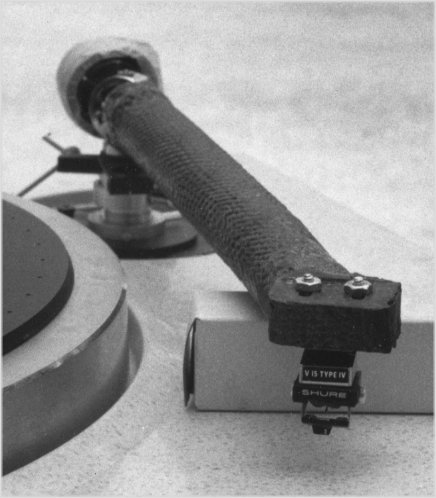NOTE (7/04): This course is no longer given!
James Boyk is still on the faculty. Email; Tel: (310) 475-8261.
Welcome to the
Caltech Music Lab
Est. 1979
James Boyk, Director
(email home consulting)
1979-2004
Celebrating a Quarter-Century
of "Projects in Music & Science"
and the Music Lab
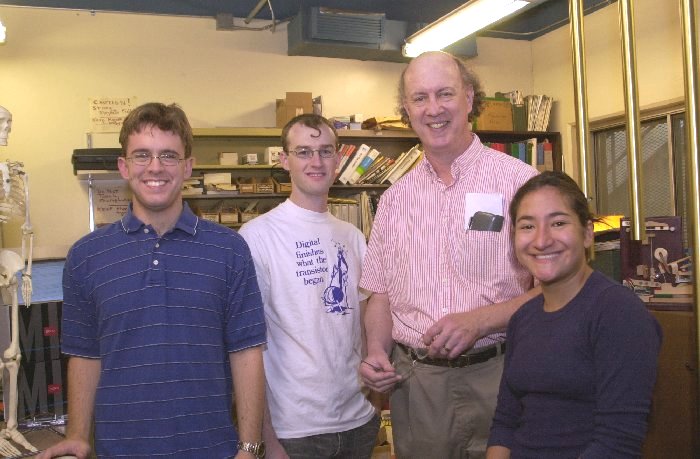
Spring, 2004: the 25th year of "Projects in Music & Science"
Sean Hardesty '04, Joshua Adams '04 (TA), James Boyk, Tamara Becher '04
Absent: Randy White '04, Jason Raycroft '04, Richie Wirz (G), Adam Bongarzone '05,
Absent: Chia Hsin Suen '05, Stephen Berardi '04, David Hedley '04.
Note: At far left is "Hubert" the skeleton, used in piano lessons. At right, behind Ms. Becher, are three tubular bells used in audio tests, the generous gift of Ludwig/Musseer division of Selmer; the complexity of their sound is demanding and therefore revealing of equipment performance. Just visible lower down is the hammer and part of the mechanism of a grand-piano action-demonstrator, generous gift of Yamaha Corp. Josh Adams's shirt says "Digital finishes what the transistor began," James Boyk's motto from the '80's.
Student Projects, Spring 2004Spectral Analysis of a Ukulele
Sean Hardesty '04
Low-Distortion Microphone PreampDavid Hedley '04
Software Synthesizer/Sequencer
Steve Berardi '04
Binaural Microphone
Tamara Becher '04
Student Projects, Winter 2004Portable Microphone Preamplifier
Jared Updike '05
Converting Images to Sound
Jessie Suen '05
Loudspeaker Design Informed by Listening
Kevin Duncklee '05
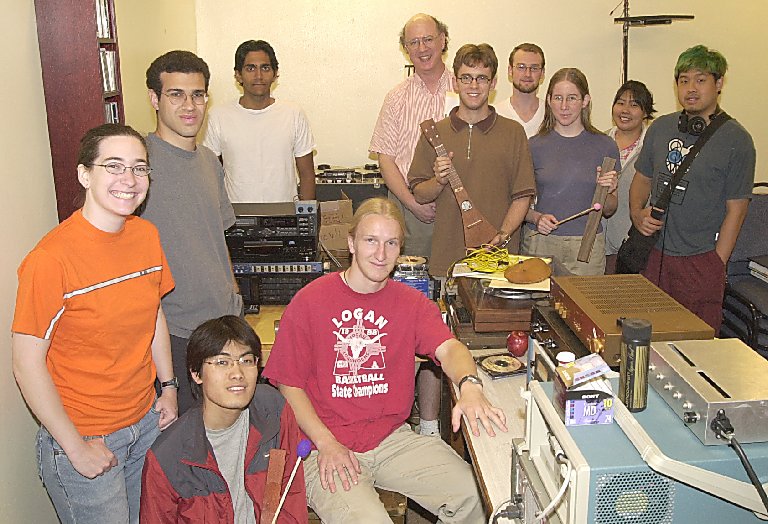
Spring, 2003: the 24th year of "Projects in Music & Science"
Front group: Clara Graham '03, TA Leon Bellan '03 (standing), Justin Kao '03 (seated), Alastair Kusack '03.
Middle group at right: Sean Hardesty '04, Krista Ehinger '03, Jonathan Chang '03.
Rear group: Ramanujan Srinivasan '04, James Boyk, Joshua Adams '03, Cecile Lim '03.
Absent: Weiwei Yang '03, Gene Short '04, Kyle Bradley '05, Viji Balaraman (Grad student).
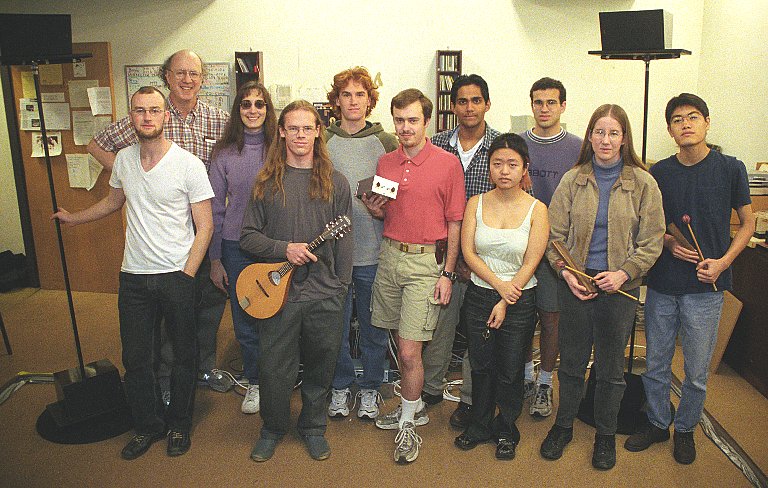
Winter, 2003: the 24th year of "Projects in Music & Science"
Front Row: Joshua Adams '03, Kyle Bradley '05, Michael Boeddiker '03, Weiwei Yang '03, Krista Ehinger '03, Justin Kao '03
Back Row: James Boyk, Tasha Vanesian '03, Gene Short '04, Ramanujan Srinivasan '04, Teaching Assistant Leon Bellan '03.
Absent: Cecile Lim '03, Viji Balaraman (Grad student), Clara Graham '03
Student Projects, 2003Making, Measuring & Simulating a Marimba Bar
Krista Ehinger '03 and Justin Kao '03
Music Composition by a Genetic Algorithm
Weiwei Yang '03 and Ramanujan Srinivasan '04
Seeking a Musical Metric
Kyle E. Bradley '05
Toward a Pitch-Correction Algorithm
Cecile Lim '03
Acoustic Simulator
Clara Graham '03
Synthesizing Instrument Sound
Tasha Vanesian '03
Electric Sitar
Viji Balaraman (Grad student)
Microphone Preamplifier
Michael Boeddiker '03 and Gene Short '04
Reading About & Listening to Ambisonics
Joshua Adams '03
Evaluating a Student-Built Mike Preamp, May 28, 2003
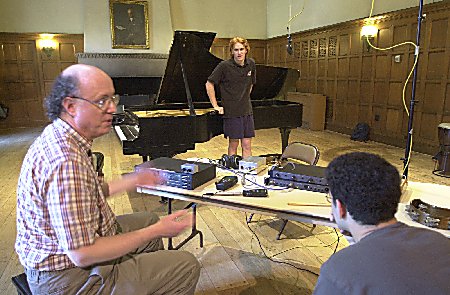
Dabney Lounge's excellent acoustics are a necessity for our work. Here, we do a listening test of a mike preamp built by Michael Boeddiker '03 (see group picture above) and Gene Short '04, who stands by the mike ready to announce the first track of the test recording. James Boyk and TA Leon Bellan '03 are in the foreground. The Short/Boeddiker preamp is the small silver box; it's being compared to the commercial preamp from Gordon Audio next to it. At left front is an Alesis Masterlink digital recorder.
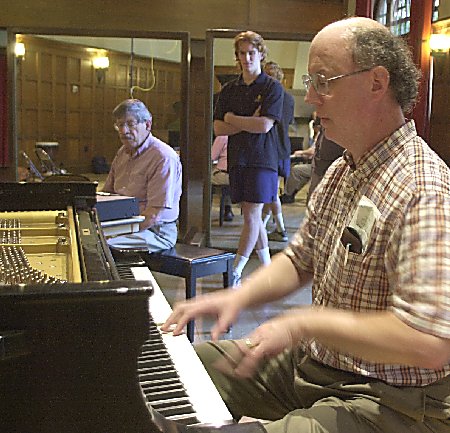
James Boyk provides piano sound for the comparison. Piano chords are extremely demanding of audio gear and thus help reveal defects (and virtues!) Gene Short listens in background with Peter Sutheim of Earworks Acoustics, a long-time friend of the music lab.
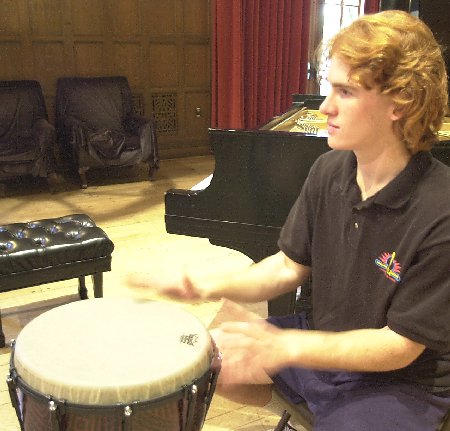
Gene provides drum sound.
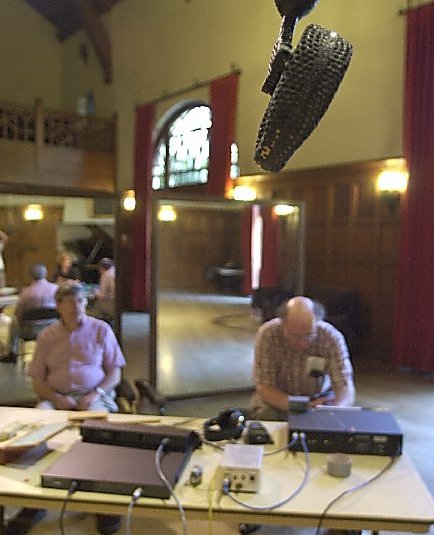
The microphone is the BBC-designed Coles 4038, a "ribbon" mike designed in the early 50's and still made. Its very high quality helps us be confident that we will hear differences in the preamps rather than limitations of the microphone. Dabney Lounge's high ceiling is one reason for its good sound; another is its hardwood floor suspended over air. Dabney's lovely reverberant decay is crucial for testing audio gear; for the ability to capture and reproduce reverberation is one of the ways in which different pieces of audio gear differ most palpably.
Music is unique among the arts in the number and significance of its connections with the sciences. In this course, a small number of unusually motivated students, singly or in groups, carry out projects exploring these connections. Projects require approval of the instructor; may be continued into a second academic year for credit (again with permission of instructor); and may be done for double credit with EE91, with permission of both instructors. The first quarter is devoted not to project work but to "analytic listening to live and reproduced music." Enrollment in the first quarter does not require permission, and is not a prerequisite to doing a project. "Projects in Music & Science" has been given every year since 1979, when it was founded by James Boyk at the invitation of Caltech President Marvin Goldberger.
"Projects in Music & Science"
EE/CS 107, Mu 17
New: Gerald J. Sussman, James Boyk, "Small-signal distortion in feedback amplifiers for audio." Published in this web site in both Acrobat and Postscript formats. April 20, 2003.
Requirements and schedule for the first quarter: "Analytic listening to live and reproduced music.".
Introduction to decibels
Improving your writing through editing
Rules for naming the notes of major scales
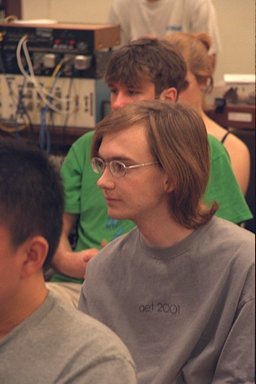
Music Lab Auditioning Facility
Evaluations for the audio industry.
Current Research
Perception vs. measurement in audio.
Former students!
Keep in touch with information about yourself and other Music Lab alums.
Grateful thanks to:
Aco-Pacific, Acoustic Research, Agilent, Alesis, Alpha Wire & Cable, Ampex,
Apogee Electronics, Communication Research, Endevco, Fluke, David Hafler Co.,
Harman International, Haselton Heavy Industries, Hitachi Wire & Cable, Ludwig/Musser,
Mastering Lab Studio Products, Nakamichi, NHT, NTI, Panasonic, Pioneer Electronics,
Sescom, Sheffield Lab, Sony, SoundCoat, Switchcraft, Tektronix.
Comments on
"Projects in Music & Science"
from former students and others
Comments on James Boyk's Other ActivitiesAlive! with Music | Recordings | Music Lessons & Coaching
Publications, Seminars & Media Coverage
Abstract: We examine how intermodulation distortion of small two-tone signals is affected by adding degenerative feedback to three types of elementary amplifier circuits (single-ended, push-pull pair, and differential pair), each implemented with three types of active device (FET, BJT and vacuum triode). Although high precision numerical methods are employed in our analysis, the active devices are modeled with rather simple models. We have not investigated the consequences of more elaborate models. Though negative feedback usually improves the distortion characteristics of an amplifier, we find that in some cases it makes the distortion "messier." For instance, a common-source FET amplifier without feedback has a distortion spectrum displaying exactly four spurious spectral lines; adding feedback introduces tier upon tier of high-order intermodulation products spanning the full bandwidth of the amplifier (as suggested by Crowhurst in 1957). In a class-B complementary-pair FET amplifier, feedback mysteriously boosts specific high-order distortion products. The distortions we are dealing with are small, but we speculate that they may be psychoacoustically significant. This work also casts light on the relative virtues of the three types of active devices and the three circuit types. For instance, a FET pair run in class-A produces zero distortion even without feedback.James Boyk, "Has Digital Audio Come of Age?" Talk for EE Seminars, Dec. 1, 1999.
Despite Compact Disk's popular acceptance, its sound quality has been criticized unremittingly by demanding listeners. Boyk recounts two listening experiences which indicate that newer formats of digital audio may now be arriving at a point of acceptability.-----, There's Life Above 20 Kilohertz: A Survey of Musical-Instrument Spectra to 102.4 kHz"
"At least one member of each instrument family (strings, woodwinds, brass and percussion) produces energy to 40 kHz or above, and the spectra of some instruments reach the measurement limit of 102.4 kHz."J. Boyk, Mark Fishman, Greg Jensen, Bruce Miller, Demonstration of Stereo Microphone Technique Compact Disk, Performance Recordings(R) pr6cd.
J. Boyk, "1960 vs. 1985 in Recording: A Quarter-Century of Degradation." Seminar for Ed Posner's Communications Working Group, April 11, 1985.
C. Minor, M. Todorovich, J. Boyk, G. P. Moore, "A Computer-Based Keyboard Monitor for studying Timing Performance in Pianists," in Timing and Time Perception, J. Gibbon and L. Allen, eds. Annals of New York Academy of Science 1984; 423, 651.
Ivars Peterson, "Analog 'Apples' and Digital 'Oranges'," Science News, March 12, 1983 (cover story).
J. Boyk, "Esthetic Perceptions and Technical Decisions in the Production of a Piano Recording." Seminar for Ed Posner's Communications Working Group.
-----, "A Listening Test of Digital Audio." Seminar for Ed Posner's Communications Working Group, Sept. 30, 1982. Repeated for Division of Humanities & Social Sciences. Repeated at Bolt, Beranek, Newman, Canoga Park.
-----, "The Subjective vs. Objective Debate in Audio and the Current State of the Art." Seminar for Ed Posner's Communications Working Group. Repeated at Hewlett-Packard Research Labs, Palo Alto, March 24, 1981.
Other articles and books by James Boyk.
2001-2002
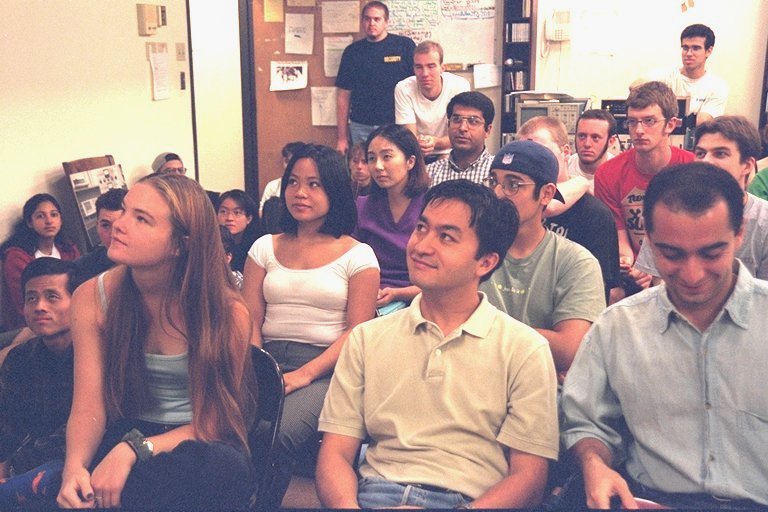
Fall, 2001 Record enrollment in first term.
(16 more students are out of sight to the right.) This term is devoted to "analytic listening to live and reproduced music." The second term, in which project work begins, had an enrollment of 11, also a record and a very large number for a course of independent projects.
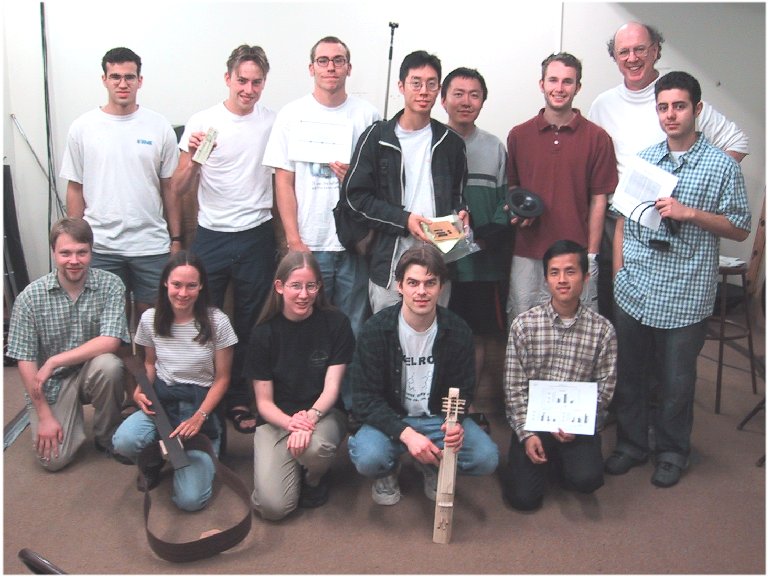
Spring, 2002: the 23rd year of EE/Mu 107, "Projects in Music & Science"
Upper Row, L. to R.: Leon Bellan '03, Teaching Assistant. James Burgess '03 (Project: A variety of pickups for electric instruments), Matt Ashman '02 ("Subtracting" reverberation from recordings), Viet Tran (grad student) and Frank Yu '02 (Digital/Analog converters), Matt Patterson '04 (Listening-evaluations of speaker drivers), James Boyk, Mauricio Cordero '03 (How is memorization of number sequences affected by tones accompanying the numbers?).
Lower Row: Timothy Dolch '03 (Fractal dimension of music), Deborah Eason '02 (Measuring resonances of parts and assemblies of acoustic guitar during construction), Krista Ehinger '03 and Sam Williams '02 (Electric violins), Robert Lin (grad student) (Effect of "distractor" tones on judgment of pitch relationships).
Student Projects, 2002Acoustic Guitar
Deborah Eason '02
Electric Violin
Krista Ehinger '03, Sam Williams '02
Musical Saw
Morgan Venable '02
Physical Modeling of a String
Matt Ashman '02
Pitch Perception
Robert Lin, Grad Student in EE
The Psychoacoustic Memory Project
Mauricio Cordero '03, Ellen Wei '02, David Zaragoza '02
Inductive Pickups - James Burgess '03, Hermes Huang '04
Previous Years Spring, 2001: Leon Bellan designed and built the electrostatic speakers in the foreground; Christof Baranec and Lu Gan, along with the absent Ben Gudlewski, did the woofers on which the three students are sitting.
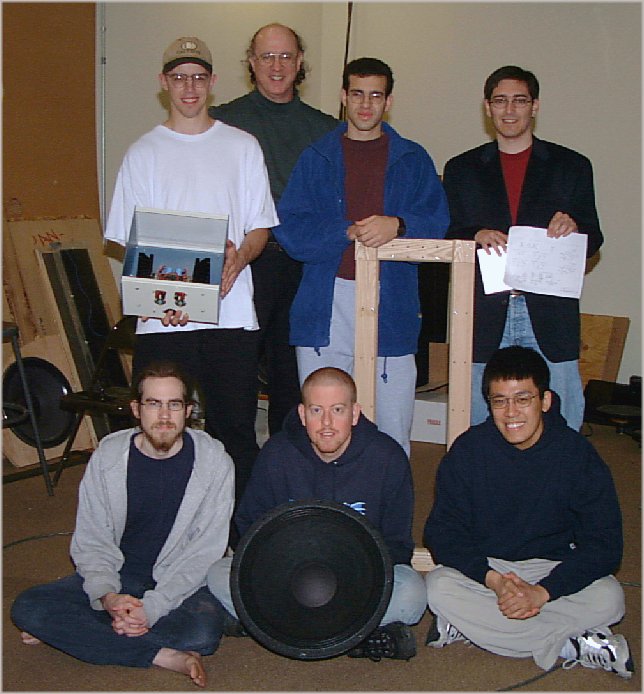
March, 2001 - James Boyk with students in "Projects in Music & Science" (EE107/Mu17):
(Standing) Brad Blakestad '02 with the Nelson Pass-designed Zen amp he's studying and auditioning (originally built by Steve Ginzburg '98)
Leon Bellan '03 with the frame of his electrostatic speaker,
Eugene Zarakhovsky '01 with his digital/analog converter;
(Seated) Ben Gudlewski '01, Christoph Baranec '01 and Lu Gan '01 with the 18" driver of their subwoofer design project.
(Absent) Jonathan Leong '01 (instantaneous current draw of loudspeakers);
B. J. Horn '01 (a variety of listening tests);
Dave Antonio '02 (building a guitar);
James Hansen '02 (effects of mike placement on recorded sound);
Shahram Ardalan '01 (TA) ("passive preamp").
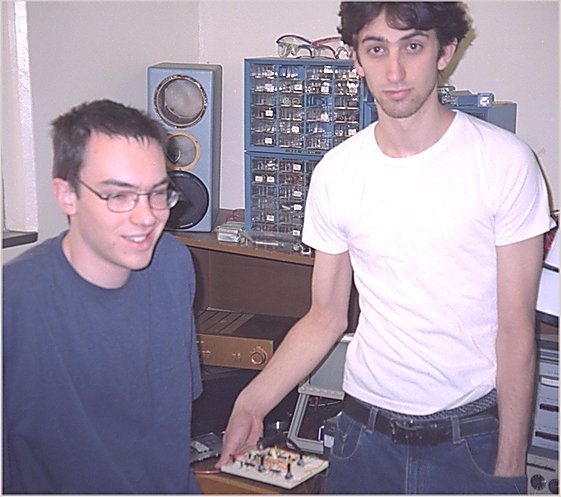
Spring, 2001: Tim Jones and Sam Thompson with their analog synthesizer board
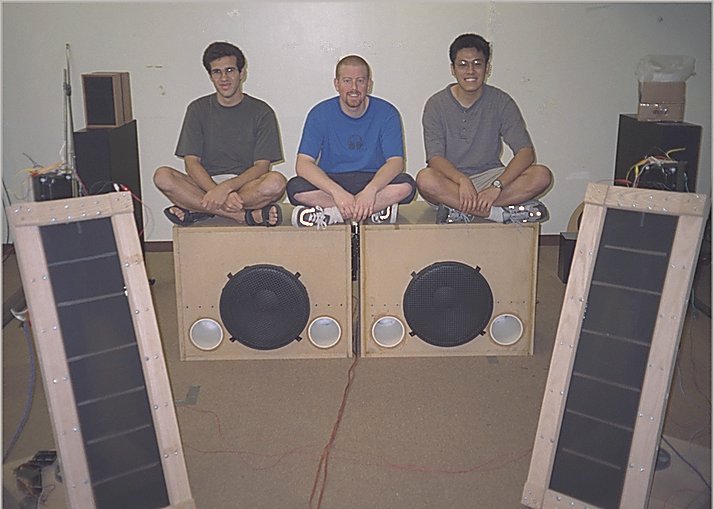
January, 2001 - Above, James Boyk and students Eugene Zarakhovsky, Leon Bellan '03 and B. J. Horn listen to violist Sean Hardesty '04 warming up for a recording made in parallel on two digital recorders, the Tascam DA-45HR and the Alesis Masterlink. Auditioning the two recordings (at The Mastering Lab, thanks to Mr. Doug Sax) revealed the superiority of one unit, which the Lab will acquire. This experience was also a part of B. J. Horn's course project of learning about how to do listening evaluations. Below, trumpeter Bill Bing, conductor of the Caltech-Oxy Concert Band, kindly assisted in the test.
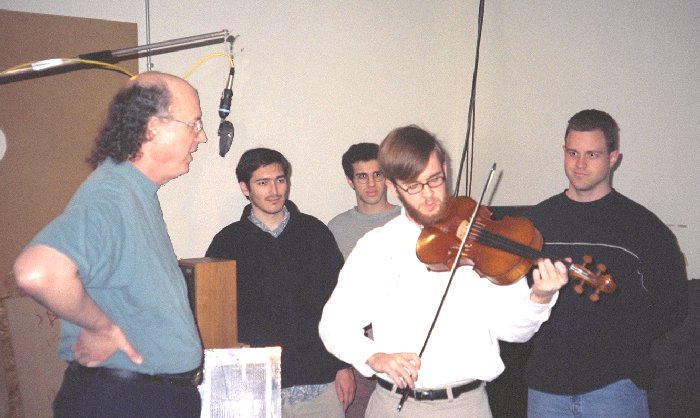
Circa 1989 - John Schuster '89 discusses his and Victor Chan's giant subwoofers with James Boyk and Brian Patterson '89. An accelerometer is seen mounted at one of fourteen measurement points on the front panel; its output is being evaluated using a Tektronix scope and Hewlett-Packard spectrum analyzer (gifts of the manufacturers). The woofer is a Hartley 24; cabinet dimensions are 3 x 5 x 8 feet. (An LS3/5A speaker on top gives the scale.) The front panel uses constrained-layer damping, with custom material kindly supplied by SoundCoat; all other panels are double-walled with an inch of sand between. Each of the two cabinets weighed 1800 pounds.
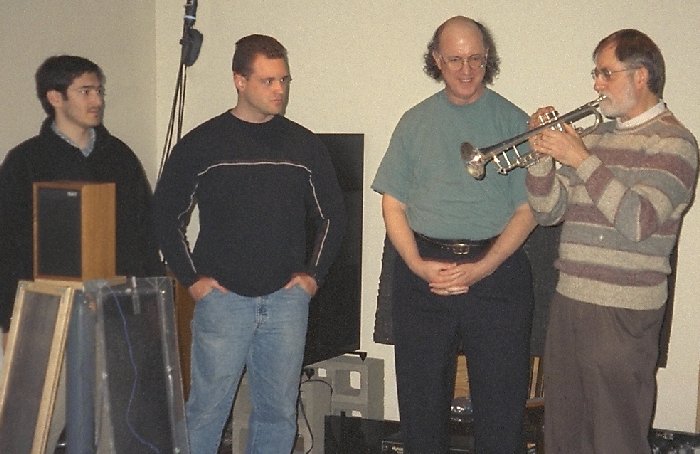
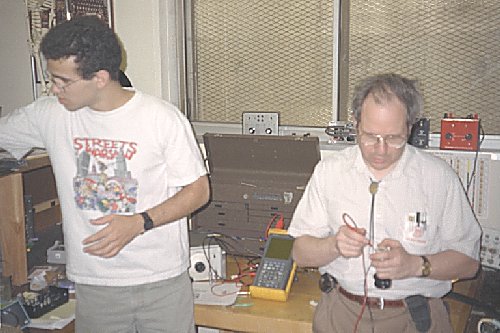
June, 2001 - Leon Bellan '03 with Prof. G. J. Sussman of MIT. Photo: Julie Sussman.

March, 2001 - James Boyk with his own long-term project, Magnesaurus.
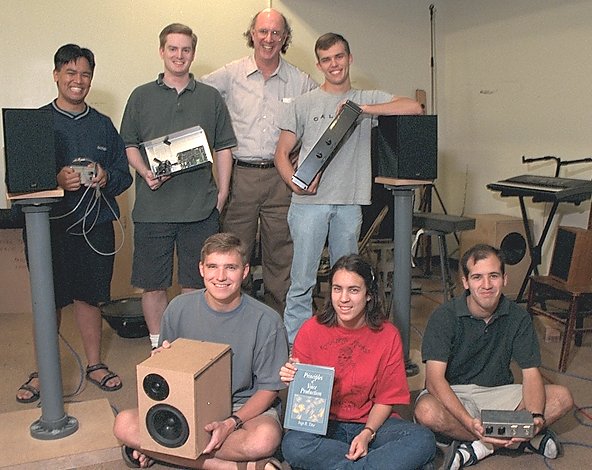
Spring, 1999 - James Boyk with students in "Projects in Music & Science" (EE107/Mu17):
(Standing) Ron Dollete, Scott Kee, Andy Cashion;
(Seated) Ian Swett, Brigitte Roth, Ben Brantley (TA).
(Absent) Eric Bogs, Steven Wexler, Brian Frazier.

Dave Risher and Mike Mossey test various ways of damping speaker boxes (represented by four-sided structures incorporating various method of damping). The mechanism they designed and built throws a Superball at reproducible speed and angle onto the structure under test. An accelerometer picks up the impulse, which is displayed on a Tektronix storage 'scope and analyzed on an H-P FFT analyzer. (The Superball is caught in the bag.) Below, a closer view of the equipment.
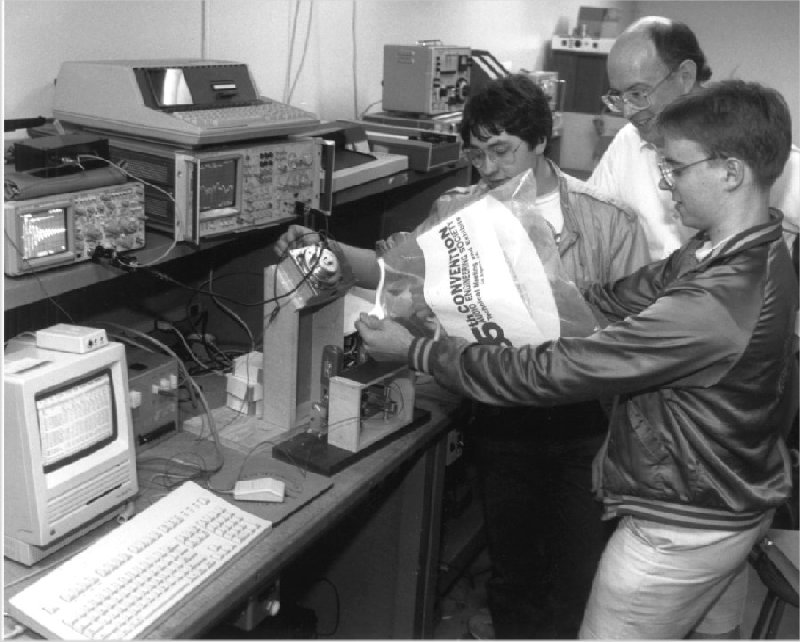
1981: After learning about critical listening, Rick Walker designed and built a mike preamp to perceptual criteria rather than the usual specs; it's at left, on its power supply. Mike Todorovich and Craig Minor placed a bank of ultra-light switches under a piano keyboard--leaving the "touch" unaffected--and connected them to computer circuitry (in the box with keypad and red-tinted window) to study pianists' timing accuracy. This resulted in a paper with Prof. G. P. Moore of USC, "A Computer-Based Keyboard Monitor for Studying Timing Performance in Pianists" in Timing and Time Perception, J. Gibbon and L. Allen, eds. Annals of New York Academy of Science 1984; 423, 651; the paper demonstrates that James Boyk averages flawless timing in "two-against-three." Joe White's two-way speaker with external crossover was instructive, in that the resistance of the air-core inductors was high enough to disturb the frequency response. The solution would have been to use either ferrite-core inductors or #8 wire. Photo: J. Boyk.
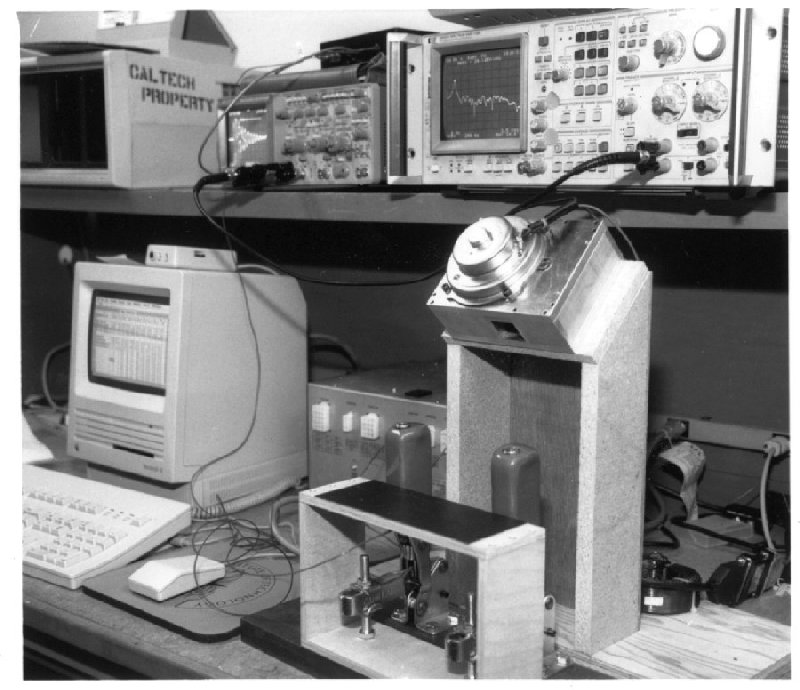
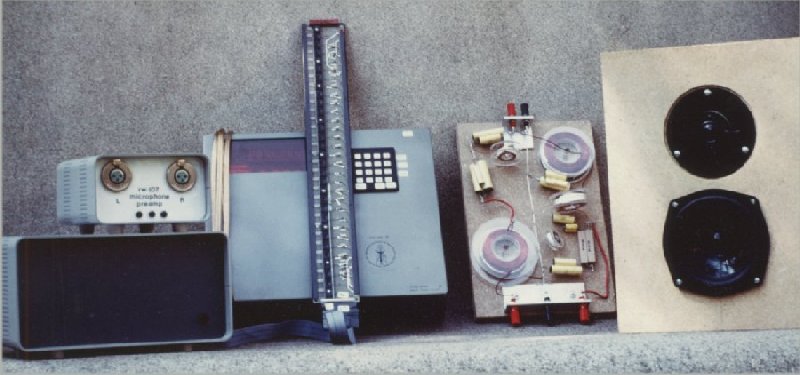
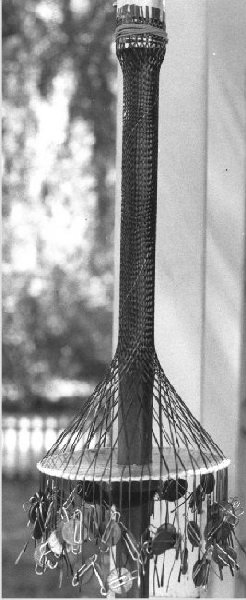
A tonearm being woven from carbon fiber; project of undergrad Chris Hougen. Below, the completed arm. Photos: J. Boyk
